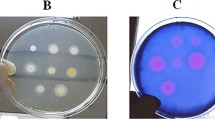Abstract
During a six month period, 191 isolates of coagulase-negative staphylococci from blood, urine, cerebrospinal fluid and heart valves were identified to species level and tested for antimicrobial susceptibility. Seventy-one percent of isolates wereStaphylococcus epidermidis, 8 %Staphylococcus warneri, 7 %Staphylococcus hominis, 7 %Staphylococcus haemolyticus, 4 %Staphylococcus capitis, 2 %Staphylococcus saprophyticus and 1 %Staphylococcus cohnii. Approximately 4 % of isolates were felt to be associated with infection. Overall, 18% of isolates were susceptible to penicillin G, 61 % oxacillin, 98 % cephalothin, 98 % cefamandole, 72 % cefotaxime, 95 % cefsulodin, 76 % gentamicin, 64 % clindamycin and 98 % rifampicin. All isolates were susceptible to vancomycin. Vancomycin, rifampicin, cephalothin and cefamandole showed excellent activity against oxacillin-resistant isolates. With one exception, speciation was not helpful in determining whether or not an isolate was associated with infection.
Similar content being viewed by others
References
Sitges-Serra, A., Puig, P., Jaurrieta, E., Garau, J., Alastrue, A., Sitges-Creus, A.: Catheter sepsis due toStaphylococcus epidermidis during parenteral nutrition. Surgery, Gynecology and Obstetrics 1980, 151: 481–483.
Young, L. S.: Nosocomial infections in the immunocompromised adult. American Journal of Medicine 1981, 80: 398–403.
Bender, J. W., Hughes, W. T.: FatalStaphylococcus epidermidis infection following bone marrow transplantation. Johns Hopkins Medical Journal 1980, 146: 13–15.
Christensen, G. D., Bisno, A. L., Parisi, J. T., McLaughlin, B., Hester, M. G., Luther, R. W.: Nosocomial septicemia due to multiply antibiotic-resistantStaphylococcus epidermidis 1982, 96: 1–10.
Sabath, L. D., Garner, C., Wilcox, C., Finland, M.: Susceptibility ofStaphylococcus aureus andStaphylococcus epidermidis to 65 antibiotics. Antimicrobial Agents and Chemotherapy 1976, 9: 962–969.
Kloos, W. E., Schleifer, K. H.: Isolation and characterization of staphylococci from human skin. Part 1. Amended descriptions ofStaphylococcus epidermidis andStaphylococcus saprophyticus and descriptions of three new species:Staphylococcus cohnii, Staphylococcus haemolyticus andStaphylococcus xylosus. International Journal of Systematic Bacteriology 1975, 25: 50–61.
Kloos, W. E., Schleifer, K. H.: Isolation and characterization of staphylococci from human skin, Part II. Descriptions of four new species:Staphylococcus warneri, Staphylococcus capitis, Staphylococcus hominis andStaphylococcus simulans. International Journal of Systematic Bacteriology 1975, 25: 62–79.
Kloos, W. E., Schleifer, K. H., Smith, R. F.: Characterization ofStaphylococcus sciuri sp. nov and its subspecies. International Journal of Systematic Bacteriology 1976, 26: 22–37.
Kloos, W. E., Schleifer, K. H.: Simplified scheme for routine identification for humanStaphylococcus species. Journal of Clinical Microbiology 1975, 1: 82–88.
Kaplan, R. L.: Rapid methods in microbiology. II. Rapid identification of gram positive organisms. American Journal of Medical Technology 1981, 47: 687–690.
Vera, H. D., Power, D. A.: Media reagents, and stains. In: Lennetz, E. H., Balows, A., Hausler, W. J., Truant, J. D. (ed.): Manual of clinical microbiology. American Society for Microbiology, Washington, 1980, p. 990.
National Committee for Clinical Laboratory Standards: Performance standards for antimicrobial disc susceptibility tests. Approved standard: ASM-2, NCCLS, Villanova, 1979.
Marsik, F. J., Brake, S.: Species identification and susceptibility to 17 antibiotics of coagulasenegative staphylococci isolated from clinical specimens. Journal of Clinical Microbiology 1982, 15: 640–645.
Oeding, P., Digranes, A.: Classification of coagulase-negative staphylococci in the diagnostic laboratory. Acta Pathologica et Microbiologica Scandinavia (B) 1977, 85: 136–142.
John, J. F., Gramling, P. K., O'Dell, N. M.: Species identification of coagulase-negative staphylococci from urinary tract isolates. Journal of Clinical Microbiology 1978, 8: 435–437.
Archer, G. L.: Antimicrobial susceptibility and selection of resistance amongStaphylococcus epidermidis isolates recovered from patients with infections of indwelling foreign devices. Antimicrobial Agents and Chemotherapy 1978, 14: 353–359.
Author information
Authors and Affiliations
Rights and permissions
About this article
Cite this article
Smith, D.J., Kaplan, R.L., Landau, W. et al. Speciation and antibiotic susceptibility patterns of coagulase-negative staphylococci. Eur. J, Clin. Microbiol. 1, 228–232 (1982). https://doi.org/10.1007/BF02019713
Issue Date:
DOI: https://doi.org/10.1007/BF02019713




